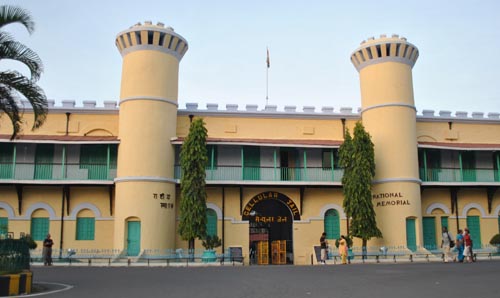Cellular Jail

Information on Cellular Jail (Andaman Nicobar) - History & Architecture
Situated at the andaman and nicobar islands the cellular jail (Alafastan Jail) better known as "kala pani" (Black water) was basically prison for the freedom fighters of India during the colonial rule. The monument reveals the brutal torture faced by the imprisoned freedom fighter. Many of the freedom fighters were hanged till death, the remaining were sent to the cellular jail. Batukeshwar Dutt, Veer Savarker were amongst the imprisoned. Presently it is the national memorial monument highly esteemed by the Indians.
Cellular Jail Architecture
The architecture comprised of a central tower and the 7 buildings radiated outwards. The construction was started in 1806 and was completed by 1906 the intersected tower was constructed to keep watch on the inmates, provided with a gong that served as alarm. The monument is made up of puce coloured bricks brought from Burma Each of The 7 buildings is three storied having small cells. The cells are 4.5 meters long and 2.7 meters broad bearing a small ventilator at about 3 meters high. As the name suggests "cellular jail" the prison has solitary cells such that no inmate could communicate with the other. Also the face of the building was constructed in such a manner that the protruding building had its gate at the opposite side making it impossible for any inmate to communicate with the other.
Cellular Jail History
The island served as a jail since the sepoy mutiny 1857. Later the jail was constructed during 1896-1906. The rebellion was successfully suppressed by the colonial rule. The rebels were killed in huge number however the remaining who survived were imprisoned for life in the cellular jail to prevent any of their participation in further mutiny. Almost two hundred people David Barry was the jailor then who was assisted by a military doctor Major James Pattition Walker, who previously served as a prison warden in Agra. In April 1868, 733 prisoners from Karachi (Pakistan) were added. The Rev. Henry Fisher Corbyn, was sent in 1863 who was the member of Bengal Ecclesiastical Establishment, later he was posted to st. Lukes Church Abottabad where he died and was buried at Old Christian Cemetery. Indians basically belonging from the Mughal Royal Family or attached with Bahadur Shah Zafar during the rebellion were dumped in the solitary cells. The cells were promptly the home for many of the freedom fighters and the word "kala pani" was used then to threaten the freedom fighters as the story of the brutal activity of the colonial rule was popular amongst the people. The convicts were gang chained and used ti build new buildings in the prison. The mid 19th century marked the peak of the struggle for independence in India thus the jail became more and more crowded with the inmates. The colonial rule smelled the possibility of the freedom fighters to escape from the jail hence a high security jail was established. Charls James Layall who served as home secretary was appointed to investigate the penal settlement at Port Blair. Charles joined A.S. Lethbridge who was a surgeon in British administration. They that the people were willingly going to the "kal pani" so as to escape from the Indian jails thus they started torturing the prisoners on their arrival at the island. This led the idea of constructing the solitary cells.
Cellular Jail Tourism Importance
The monument is respected as pilgrimage by the Indians. The brutal history of the colonial rule is remembered here. The bricks are still coloured with blood of the esteemed freedom fighters. It also reveals the miserable condition of the rebels hence it becomes the tourist attraction from all over the world.
- Andaman Nicobar Monuments
- Andhra Pradesh Monuments
- Assam Monuments
- Bihar Monuments
- Chhattisgarh Monuments
- New Delhi Monuments
- Goa Monuments
- Gujarat Monuments
- Haryana Monuments
- Himachal Pradesh Monuments
- Jammu and Kashmir Monuments
- Karnataka Monuments
- Kerala Monuments
- Madhya Pradesh Monuments
- Maharashtra Monuments
- Odisha Monuments
- Punjab Monuments
- Rajasthan Monuments
- Tamil Nadu Monuments
- Telangana Monuments
- Uttar Pradesh Monuments
- West Bengal Monuments